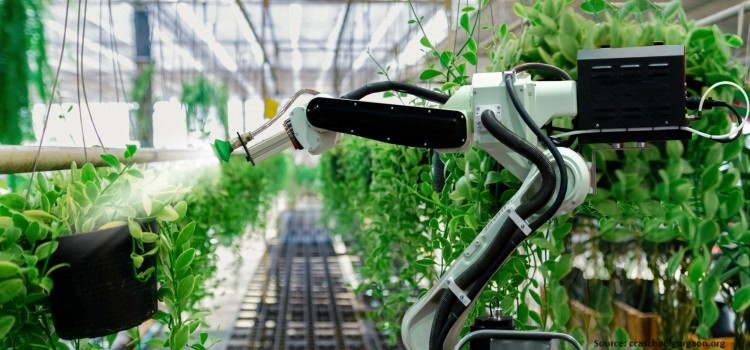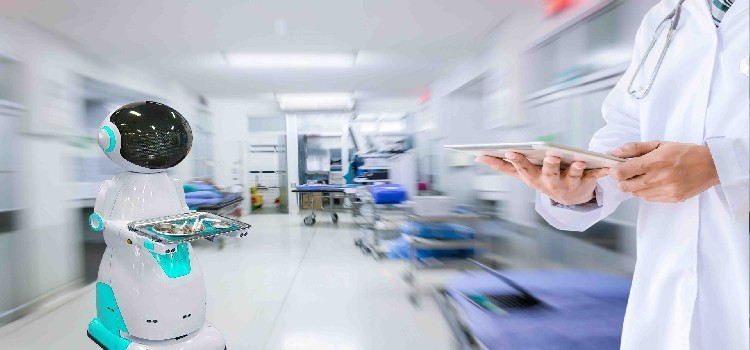
Agriculture Robots Market by Type (Driverless Tractors, Unmanned Aerial Vehicles (UAVs), Milking Robots, Automated Harvest Robots, and Others), Offering (Hardware, Software, and Services), Farming Type (Indoor Farming and Outdoor Farming), Application (Dairy Management, Irrigation Management, Harvest Management, Soil Management, Inventory Management, and Others), and End User (Field Crops, Fruits & Vegetables, Livestock, and Others) – Global Opportunity Analysis and Industry Forecast 2024–2030
Industry: ICT & Media | Publish Date: 09-Mar-2023 | No of Pages: 500 | No. of Tables: 408 | No. of Figures: 367 | Format: PDF | Report Code : N/A
Market Overview
The global Agriculture Robots Market was valued at USD 7.06 billion in 2022, and is predicted to reach USD 24 billion by 2030, with a CAGR of 15.5% from 2023 to 2030. Agricultural robots, also known as agribots, are automated or semi-automated machines designed that perform various tasks in the field of agriculture. These tasks include planting, harvesting, monitoring, and spraying crops. They aim to increase efficiency, productivity, and accuracy in agriculture while reducing the need for manual labor and improving working conditions for farmers. Agribots utilizes advanced technologies such as computer vision, artificial intelligence (AI), and others.
Agribots can monitor crops for early detection of diseases and pests, allowing prompt and efficient treatment. Moreover, automated sprayers can be used to apply pesticides, herbicides, and fertilizers, reducing the risk of human exposure to harmful chemicals and improving application accuracy. These robots can create detailed maps of fields and crops, helping farmers make informed decisions about planting, fertilization, and pest control using global positioning system (GPS) and mapping technologies.
Agriculture robots can also be used in livestock management for performing tasks, such as feed distribution and monitoring animal health. These robots improve the working conditions in an agricultural environment by enhancing crop yields and precision agriculture. Through precise application of pesticides, herbicides, and fertilizers, agribots can help improve crop yields and raise profitability for farmers. These robots can help farmers practice precision agriculture and make informed decisions about planting, fertilization, and pest control through accurate data collection and analysis.
Increasing Global Population
According to the Population Reference Bureau (PRB), the global population is projected to reach nearly 10 billion by 2050, which is expected to put significant pressure on the agriculture industry to increase productivity and efficiency. The agriculture robots industry is well positioned to meet this demand by providing innovative solutions that can help farmers produce more food while reducing costs and minimizing environmental impact.
There are some ways in which the increasing global population is driving the growth of the agriculture robots industry. These include need for increased food production, efficiency gains, precision agriculture and many more. The growing population will require more food, which will put pressure on the agriculture industry to increase its productivity. Agriculture robots can help to achieve this by improving efficiency, reducing waste, and optimizing crop yields.
Agribots can improve the efficiency of farming operations by reducing the time and labor required to perform tasks such as planting, harvesting, and fertilizing. This can help farmers to produce more food with less resources, which is essential given the growing demand for food. Moreover, precision agriculture involves using data and technology to optimize crop yields and reduce waste. Agriculture robots can play a key role in precision agriculture by providing high-resolution data on soil conditions, plant growth, and weather patterns. This information can be used to make more informed decisions about planting, harvesting, and fertilizing, which can help to increase yields and reduce costs.
Shortage of Labor
Agriculture is a labor-intensive industry, and many regions are experiencing labor shortages due to factors such as aging populations and urbanization. Robotics can help to fill this gap by performing tasks that are difficult or impossible for humans to do. Over the years, there has been declination in number of farm labor due to occupational changes and lower wages in the agriculture sector. Such labor scarcity poses serious challenges for farmers as it delays the production of crops.
Thus, robots can work for long hours without breaks and automate repetitive farming task, such as monitoring fields, handling manure, and picking up crops. Therefore, farmers across the globe are widely adopting robotic solutions for their farms.
Lack of Technology Awareness Among Farmers
Though agricultural robots provide multiple benefits for increasing productivity and profitability of farmers, many of them are not aware of the robotic technology. In many developing and under-developed countries, farmers still use traditional farming methods to grow crops. The main reason for this is the low technical knowledge about how to operate these robots. This lack of knowledge discourages the farmers from investing in these robots. Moreover, many farmers cannot afford to buy these robots as they require huge cost of installation. These factors restrain market growth.
Growing Development of Real-Time Field Robots
The application of robots and automation technology in agriculture leads to effective farm management and increases productivity. Over the years, a significant amount of research has been done to implement robotic solutions for various farming activities, such as planting, spraying, monitoring, and harvesting. A growing number of technology companies are creating real-time field robots, aimed at automating the agricultural process and lowering input costs for farmers.
These factors allow them to focus on other crucial tasks. For instance, in March 2021, John Deere, an American manufacturer and provider of agricultural solutions, launched ExactRate. It is a new technology that helps farmers fertilize their crops faster than before. The 8RX Tractor, which is equipped with 1600-gallon fertilizer capacity, is expected to significantly reduce the number of trips required for farmers. This advancement is anticipated to drive substantial growth opportunities for the market.
North America is Projected to Dominate the Agriculture Robots Market
Agriculture continues to play a crucial role in the economies of both, the U.S. and Canada. The agricultural sector contributes over USD 164.7 billion to the U.S. economy. The implementation of free trade agreements such as North American Free Trade Agreement (NAFTA) has had a significant impact on agriculture in North America, enabling increased trade and exports of agricultural products between the U.S., Canada, and Mexico.
The Food and Agriculture Organization of the United Nations (FAO) is active in North America, collaborating with farmers, ranchers, and other stakeholders to meet the growing demand for food while conserving lands and waters for future generations.
Companies in this region are heavily invested in R&D and innovation of various agribots to improve the working circumstances of farmers. For instance, in May 2022, John Deere planned to have an autonomous electric tractor and electric farm equipment in each of its turf and compact utility product lines by 2026. With this development, horticulture farmers will be able to use this intelligent and efficient equipment throughout their farms, making a significant and transformative impact on high-value crop production.
Moreover, there are many ongoing collaborations between various prominent universities and software companies to develop robotic solution to assist famers with advanced data that will lead to higher productivity hence driving the growth of the agribots market. For instance, in June 2022, Solinftec teamed up with the University of Saskatchewan to unveil its new AgTech robotic platform in Canada. The goal is to provide farmers and agronomists with advanced information that will result in increased yields, more efficient use of resources, and reduced environmental impact, and help meet the growing global demand for food.
Europe Witnessed Substantial Growth in Agribots Industry
There is a significant demand for agriculture robots in Europe. Europe is a home to some of the world's leading companies, such as Lely, BouMatic Robotics, and DeLaval, in the agriculture robots industry. These companies are investing in the development of new and advanced technologies. Moreover, governments in European countries are supporting the growth of the agriculture robots industry through funding for research & development and incentives for farmers to adopt the technology. As most of the European countries are facing major labor shortage in the agriculture sector thus inclining more towards the robotic technology in all the significant sectors.
For instance, in December 2022, The Department for Environment, Food and Rural Affairs announced the match-funding projects in partnership with the UK Research and Innovation (UKRI). The U.K. Government invited farmers, growers, businesses, and researchers to apply for a share of USD 12.03 million. This funding is expected to boost productivity and sustainable farming practices through the development of automation and robotic technologies.
In addition, the adoption of Industry 4.0 technologies in agriculture, which includes the use of robotics and automation. This focus on digitalization that is driving the growth of agribots market. For instance, in December 2021, Agrointelli, a Danish AgTech developer, developed Robotti LR robot, a fully automated farming machine that combines robotics with simple and robust components. It is a cost-effective machine that is easy to integrate into the present-day farm practices.
Competitive Landscape
The agriculture robots industry includes various market players such as GEA Group, CNH Industrial, Delaval, Deere & Company, Agco Corporation, Trimble Inc., Naio Technologies, Yanmar Holdings Co. Ltd., SZ DJI Technology Co. Ltd., Boumatic, Harvest Automation Inc, Autonomous Solution Inc, Clearpath Robotics, Ageagle Aerial System, Kubota Corporation. These market players are adopting several strategies such as product launches, acquisition, and innovation across various regions to maintain their dominance in the global market. For instance, September 2022, GEA launched GEA DairyFeed F4500, an autonomously driving feeding robot. This new feeding robot is designed to help dairy farms reduce their carbon footprint and operating costs while boosting flexibility on the farm.
Moreover, in December 2022, CNH Industrial acquired a 10% stake in Stout Industrial Technology (Stout). The US-based startup is focused on smart implements for agriculture that are powered by Artificial Intelligence (AI) to allow machines to carry out tasks based on sensor-detected data. Through this acquisition, CNH Industrial will expand its operations across the U.S. and provide its robotic solutions to farmers for overcoming their limitations. In addition, in May 2022, John Deere aimed to have an autonomous electric farm tractor and electric equipment in each of its turf and compact utility product families by 2026. Through this innovation, the company aims to enhance efficiency, reduce emissions, improve safety and encourage other companies to invest in similar technologies.
Agriculture Robots Market Key Segments
By Type
-
Driverless Tractors
-
Unmanned Aerial Vehicles (UAVs)
-
Milking Robots
-
Automated Harvest Robots
-
Others
By Offering
-
Hardware
-
Software
-
Services
By Farming Type
-
Indoor Farming
-
Outdoor Farming
By Application
-
Dairy Management
-
Irrigation Management
-
Harvest Management
-
Soil Management
-
Inventory Management
-
Others
By End User
-
Field Crops
-
Fruits & Vegetables
-
Livestock
-
Others
By Region
-
North America
-
U.S
-
Canada
-
Mexico
-
-
Europe
-
Germany
-
UK
-
France
-
Spain
-
Italy
-
Netherlands
-
Denmark
-
Finland
-
Norway
-
Sweden
-
Russia
-
Rest of Europe
-
-
Asia-Pacific
-
China
-
Japan
-
India
-
Australia
-
South Korea
-
Thailand
-
Taiwan
-
Indonesia
-
Singapore
-
Rest of Asia-Pacific
-
-
RoW
-
Latin America
-
Middle East
-
Africa
-
Report Scope and Segmentation
|
Parameters |
Details |
|
Market Size in 2023 |
USD 7.06 Billion |
|
Revenue Forecast in 2030 |
USD 24 Billion |
|
Growth Rate |
CAGR of 15.5% from 2023 to 2030 |
|
Analysis Period |
2022–2030 |
|
Base Year Considered |
2022 |
|
Forecast Period |
2023–2030 |
|
Market Size Estimation |
Billion (USD) |
|
Growth Factors |
Increasing global population Shortage of labor |
|
Countries Covered |
28 |
|
Companies Profiled |
15 |
|
Market Share |
Available for 10 companies |
|
Customization Scope |
Free customization (equivalent up to 80 analysts working hours) after purchase. Addition or alteration to country, regional & segment scope. |
|
Pricing and Purchase Options |
Avail customized purchase options to meet your exact research needs. |
KEY PLAYER
-
GEA Group
-
CNH Industrial
-
Delaval
-
Deere & Company
-
Agco Corporation
-
Trimble Inc.
-
Naio Technologies
-
Yanmar Holdings Co. Ltd.
-
SZ DJI Technology Co. Ltd.
-
Boumatic
-
Harvest Automation Inc
-
Autonomous Solution Inc
-
Clearpath Robotics
-
Ageagle Aerial System
-
Kubota Corporation




 Speak to Our Analyst
Speak to Our Analyst


































